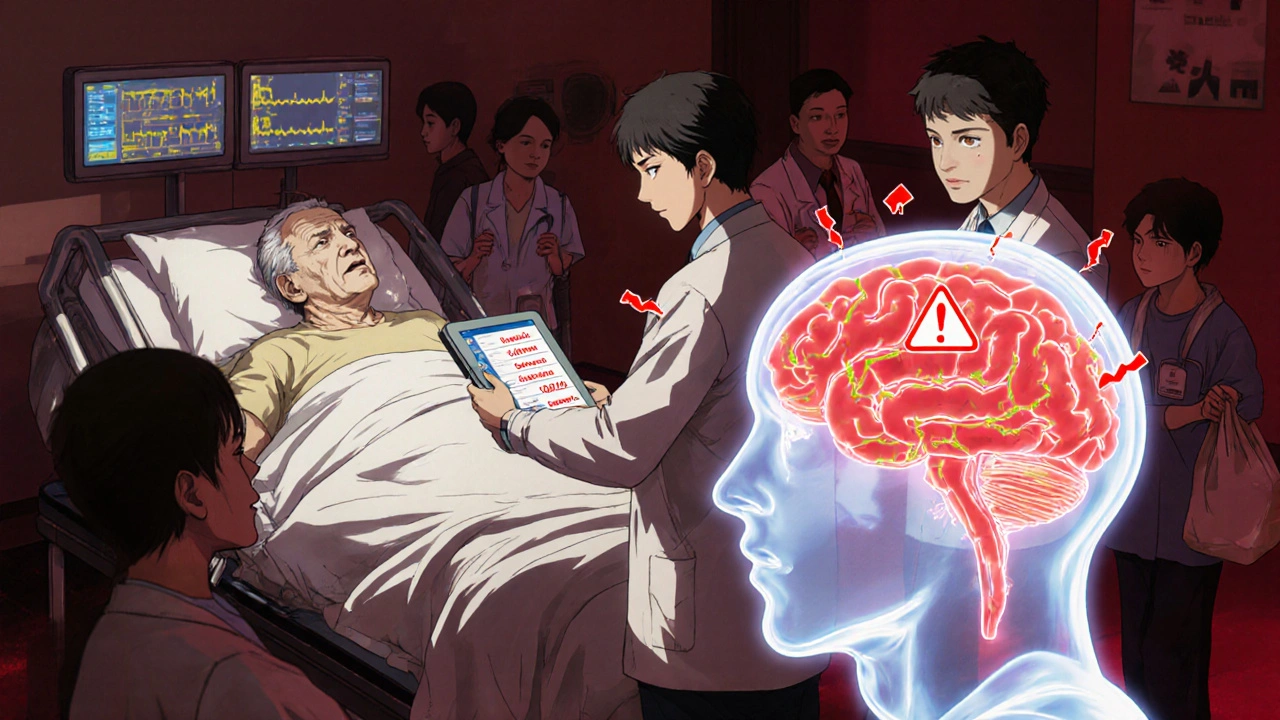When you take one sedative, your body slows down a little. Take two, and it slows down more. But take three-or mix alcohol with a sleeping pill and an anxiety med-and your breathing could stop. This isn’t hypothetical. It’s happening right now, in homes, clinics, and emergency rooms across the country. The combination of multiple central nervous system (CNS) depressants doesn’t just add up-it multiplies danger. And most people have no idea how close they are to the edge.
What Happens When Sedatives Combine?
CNS depressants work by boosting GABA, a brain chemical that tells your nervous system to calm down. That’s why drugs like diazepam, alprazolam, oxycodone, and even alcohol can help with anxiety, pain, or sleep. But when you stack them, they all hit the same brake pedal at once. The result isn’t just drowsiness. It’s respiratory depression-a dangerous drop in breathing rate that can fall to 4-6 breaths per minute, compared to the normal 12-20. Oxygen levels plunge below 85%, and within minutes, your brain starts to starve.
Emergency rooms see this every day. Patients come in confused, slurring words, barely responsive. Their pulse is slow, their skin is cool, their lips are blue. In 68% of these cases, they’re taking at least two CNS depressants together. And it’s not just illegal drugs. It’s the prescription you got for back pain, the Xanax your doctor gave you for panic attacks, and the glass of wine you had with dinner. All of them slow your breathing. Together, they can shut it down.
The Deadliest Pair: Opioids and Benzodiazepines
The most lethal combination is opioids and benzodiazepines. The FDA issued a stark warning in 2016: this mix increases the risk of fatal overdose by 2.5 to 4.5 times compared to opioids alone. Why? Because opioids suppress the brainstem’s drive to breathe, while benzodiazepines silence the brain’s ability to wake up when oxygen drops. It’s a perfect storm.
Studies show that nearly 30% of people on long-term opioid therapy also take benzodiazepines-even though guidelines from the CDC and other health agencies say this should be avoided. In 2020, over 10% of patients still received both drugs together. Many don’t realize they’re at risk. One patient might be prescribed oxycodone for arthritis and alprazolam for insomnia. They take them at different times. But the drugs linger in the body. By morning, both are still active. The next night, they do it again. Slowly, the body stops fighting the depression. Then, one night, it doesn’t wake up.
Who’s Most at Risk?
It’s not just people with substance use disorders. The biggest group at risk? Older adults. The American Geriatrics Society lists 34 CNS-active drugs that should be avoided in seniors because they increase fall risk by up to 3.4 times. When elderly patients take three or more CNS depressants, their chance of a fall-related hospitalization jumps by 45%. Many are on these meds for legitimate reasons-arthritis pain, insomnia, anxiety-but no one ever sat down with them and asked, “Are you taking anything else?”
Women are also more likely to be prescribed multiple sedatives. So are people with depression or chronic pain. A 2012 study found that those with depression were over twice as likely to use sedatives alongside opioids. And it’s not just pills. Alcohol is the most common hidden player. Nearly 13% of chronic opioid users reported drinking within two hours of taking their medication. That’s like lighting a match next to gasoline.

Long-Term Damage You Can’t See
Even if you don’t overdose, stacking sedatives takes a slow, silent toll. Long-term users report chronic fatigue, weight gain of 12-18 pounds over a year, and sexual dysfunction affecting one in three. Sleep gets worse, not better. One in four develops sleep apnea. Depression climbs to 38%, and suicidal thoughts appear in nearly one in five after six months of use. These aren’t side effects-they’re consequences of your brain being constantly suppressed.
Memory and thinking suffer too. A major study found that long-term use of multiple CNS depressants led to a 27% higher risk of cognitive decline. That’s not just forgetting where you put your keys. It’s trouble with planning, decision-making, and recognizing familiar faces. And it’s often irreversible.
What Can You Do?
First, know what you’re taking. Write down every medication, supplement, and substance you use daily-including alcohol and over-the-counter sleep aids. Many people don’t think of diphenhydramine (Benadryl) as a sedative, but it’s one. So is melatonin in high doses. Keep this list with you. Bring it to every doctor visit.
Ask your doctor: “Is this the only way to treat this?” There are alternatives. For anxiety, cognitive behavioral therapy works as well as benzodiazepines-with no risk of addiction. For sleep, sleep hygiene and CBT-I (Cognitive Behavioral Therapy for Insomnia) are proven, safer options. For pain, physical therapy, acupuncture, or non-opioid meds like gabapentin may be better choices.
If you’re on multiple CNS depressants, ask about deprescribing. That means slowly reducing or stopping one at a time under medical supervision. Studies show this cuts fall risk by 32% and reduces cognitive decline by 27% over a year. Don’t quit cold turkey-some sedatives can cause seizures if stopped suddenly. But with a plan, you can get off them safely.

What Doctors Are Doing About It
Hospitals and clinics are starting to catch up. Electronic health records now have alerts that pop up when a doctor tries to prescribe an opioid with a benzodiazepine. In places where these systems are fully used, inappropriate prescribing has dropped by 28%. Some systems now flag alcohol use too. Pharmacists are being trained to spot dangerous combinations during refill checks.
There’s also new tech on the horizon. Genetic testing for CYP450 enzymes can show if your body processes certain drugs slowly-making you more vulnerable to buildup and overdose. Early studies suggest this could reduce dangerous interactions by 22%. By 2025, most major EHR systems will require these alerts before a prescription is finalized.
Final Warning: This Isn’t Rare
People think overdoses happen to “others.” But the truth is, it’s often someone you know. A parent taking pain meds and sleeping pills. A friend using Xanax after a breakup. A relative who drinks to help with sleep. These aren’t reckless choices-they’re well-intentioned ones that went wrong because no one explained the real risk.
If you’re taking more than one CNS depressant, you’re playing Russian roulette with your breathing. There’s no safe amount when they’re mixed. The only way to eliminate the risk is to avoid combining them. And if you’re unsure, talk to your pharmacist or doctor. Don’t wait for a crisis to realize you were in danger.
Can mixing alcohol with prescription sedatives really kill you?
Yes. Alcohol is a CNS depressant, and combining it with prescription sedatives like benzodiazepines or opioids multiplies the risk of respiratory failure. Even one drink with a sleeping pill can lower your breathing rate to dangerous levels. Emergency rooms see this combination in over 40% of sedative-related overdoses. There is no safe amount of alcohol when you’re taking these drugs.
Are over-the-counter sleep aids like Benadryl or melatonin safe to mix with prescription sedatives?
No. Diphenhydramine (found in Benadryl and many sleep aids) is a potent sedative that affects the same brain pathways as prescription drugs. Melatonin, especially in doses over 5 mg, can also enhance CNS depression. Mixing these with opioids, benzodiazepines, or sleep medications increases drowsiness, confusion, and breathing risk. Always check with your pharmacist before combining any sleep aid with a prescription.
If I’ve been taking two sedatives for years, is it too late to stop one?
It’s never too late to reassess. Many people worry about withdrawal, but stopping one sedative under medical supervision is safer than continuing the combo. A gradual taper reduces risk of seizures or rebound anxiety. Studies show that even after years of use, patients who deprescribe one drug see improved alertness, memory, and balance within weeks. Talk to your doctor about a plan-it’s not about quitting everything at once, but reducing risk step by step.
Why do doctors still prescribe these combinations if they’re so dangerous?
Many doctors aren’t fully aware of the risks, or they’re trying to manage multiple conditions at once. A patient with chronic pain and anxiety might get an opioid and a benzodiazepine because each drug treats one symptom. But the combined effect is rarely discussed. Guidelines have existed since 2016, but prescribing habits change slowly. That’s why it’s critical for patients to ask questions and bring their full medication list to every appointment.
What should I do if someone I know shows signs of CNS depression?
If someone is extremely drowsy, confused, has slow or shallow breathing (fewer than 8 breaths per minute), or can’t be woken up, call emergency services immediately. Do not wait. Put them in the recovery position if they’re unconscious but breathing. If you have naloxone (Narcan) and suspect opioids are involved, administer it. Naloxone won’t reverse benzodiazepine effects, but it can help if opioids are part of the mix. Time is critical-brain damage can start within minutes.







